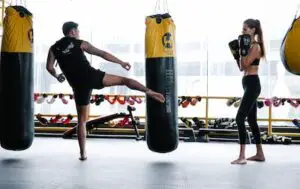As the sport of combat jiu jitsu continues to grow in popularity, more people are becoming interested in the rules and regulations of this unique style of martial arts competition. Combat jiu jitsu is a hybrid sport that combines traditional jiu jitsu techniques with striking elements borrowed from MMA and other combat sports. In this article, we will explore the rules of combat jiu jitsu and answer some common questions that beginners may have.
What is combat jiu jitsu?
Combat jiu jitsu is a grappling-based martial arts competition that incorporates open-handed strikes into grappling exchanges. Matches take place on a mat and generally last five or ten minutes, depending on the rules set by the event organizers. Combat jiu jitsu is similar to traditional jiu jitsu in terms of grappling techniques, but it differs in that competitors are allowed to strike their opponents with open-handed slaps, which can be delivered to any part of the opponent’s body except the head.
What are the rules of combat jiu jitsu?
The basic rules of combat jiu jitsu are as follows:
– Matches take place on a mat that is approximately 30 feet by 30 feet in size.
– Competitors must wear a dedicated combat jiu jitsu rash guard and shorts, as well as a mouthguard and cup (for male competitors). Other protective gear, such as shin guards, may also be allowed depending on the specific rules of the event.
– Matches can be won by submission, TKO, or decision. Submission typically occurs when one competitor forces the other to “tap out” by applying a chokehold, joint lock, or other submission technique. TKO can occur if one competitor strikes the other with enough force to cause them to lose consciousness or be unable to continue. Decision occurs if neither competitor is able to secure a submission or TKO, and the match is scored by judges based on various factors such as takedowns, successful submissions attempts, and strikes landed.
– Competitors are allowed to strike their opponents with open-handed slaps, but they are not allowed to strike the head. Strikes may be delivered to the chest, abdomen, arms, legs, or other parts of the body, as long as they are not directed at the face or head. Strikes must also be delivered with an open hand; closed-fist punches are not allowed.
– If a competitor intentionally strikes their opponent in the face or head, they may be disqualified from the match.
– If a competitor is knocked out by an opponent’s strike, the match is immediately stopped and the opponent is declared the winner.
How does combat jiu jitsu differ from traditional jiu jitsu?
The most obvious difference between combat jiu jitsu and traditional jiu jitsu is the inclusion of striking techniques. In traditional jiu jitsu competitions, striking is not allowed and matches are won solely through the application of submission techniques. Additionally, combat jiu jitsu matches tend to be more fast-paced and action-packed than traditional jiu jitsu matches, due to the added element of striking. Competitors in combat jiu jitsu must be skilled in both grappling and striking techniques in order to succeed.
Who can compete in combat jiu jitsu?
Combat jiu jitsu is open to anyone who has a solid grounding in traditional jiu jitsu techniques and is willing to train for the added challenge of incorporating striking into their game. Competitors must be at least 18 years old and in good physical condition. Additionally, competitors must be mentally and emotionally prepared to handle the pressure of competing in a combat sport.
How can I train for combat jiu jitsu?
Training for combat jiu jitsu involves a combination of traditional jiu jitsu techniques and striking drills. In addition to practicing basic grappling skills such as takedowns and submissions, competitors must also practice delivering strikes with an open hand, both from the top position and from the bottom. Training sessions may also include sparring sessions and simulated competition scenarios in order to prepare competitors for the pressure and intensity of a real match.
Where can I compete in combat jiu jitsu?
Combat jiu jitsu competitions are becoming increasingly common around the world, and many MMA and grappling events now include combat jiu jitsu matches as part of their lineup. In addition, there are several organizations that specialize in combat jiu jitsu competitions, such as the Eddie Bravo Invitational and the Combat Jiu Jitsu World Championships. Competitors can find events to compete in by searching online or checking with their local MMA or grappling gyms.
Conclusion
In conclusion, combat jiu jitsu is a dynamic and exciting sport that combines grappling techniques with open-handed strikes. To compete in combat jiu jitsu, competitors must be skilled in both grappling and striking techniques, and must be mentally and emotionally prepared to handle the pressure of a real match. By following the rules and guidelines set forth by the event organizers, competitors can stay safe and compete at their highest level.





